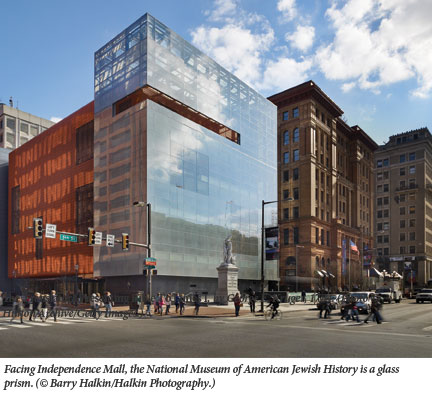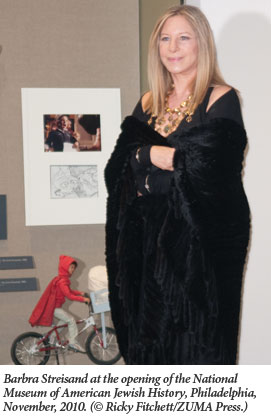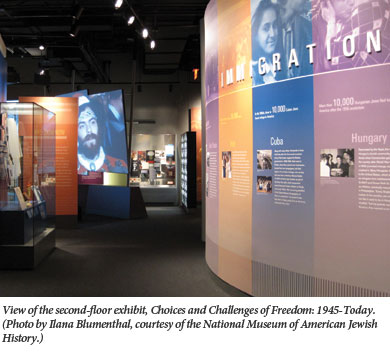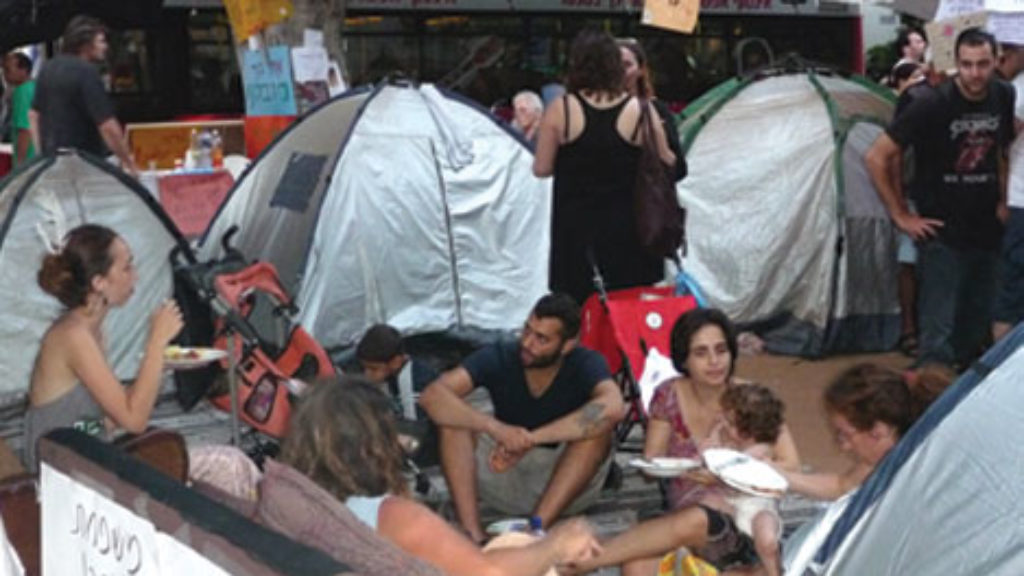Freedom Riders
The first Jew to arrive on North American shores did not stay long. Joachim Gaunse (or Gans or Ganz) was a Bohemian mining engineer who had been invited to England by the Royal Mining Company in 1581. In 1584, after the clever Gaunse achieved some notoriety by shrinking the time it took to purify copper ore (from four months to four days), he was recruited by Sir Walter Raleigh to join his expedition to the New World. Gaunse was part of the crew who settled and fortified the northern tip of Roanoke Island; chunks of smelted copper found by archaeologists are thought to have been his handiwork. But within two years, exhausted by short supplies, arduous heat, and attacks by indigenous tribes, he and the others abandoned the settlement and returned to England.
Back in England, while teaching Hebrew to gentlemen in Bristol, Gaunse was asked point-blank if he denied the divinity of Jesus Christ, the son of God. Exactly what possessed the savvy, seasoned Gaunse to quip, “What needeth the Almighty God to have a son; is He not Almighty?” is lost to time. But Gaunse’s testimony that he’d been circumcised, “brought up in the Talmud,” and never baptized suggests that he was counting on the time-honored immunity of the infidel; besides, he knew he had friends in high places. Indeed, his blasphemy case was remanded to the Queen’s Privy Council, which appears to have let him off the hook. At least there is no record of penalty or punishment.
Gaunse’s story epitomizes the American Jewish story in many respects. It is a tale of enterprise and mobility, expertise and ingratiation, adaptability and resourcefulness. But in the new National Museum of American Jewish History (NMAJH) in Philadelphia, Gaunse is simply a parenthesis for one reason: His is not a story of freedom, at least not of religious freedom. At the NMAJH, freedom—or what Abraham Cahan called “a chance to live in freedom”—becomes the key term for exploring the entirety of American Jewish life since 1654. The three-floor core exhibition, designed by Gallagher and Associates, is organized chronologically around three eras of freedom: Foundations of Freedom: 1654-1880; Dreams of Freedom: 1880-1945; and Choices and Challenges of Freedom: 1945-Today. Toward the exit lies a sweeping, multimedia Hall of Fame focusing on what eighteen luminaries from Barbra Streisand to Menachem Mendel Schneerson have made of their Jewish American freedom. And à propos of freedom, these eighteen were selected democratically in a public web-election; I myself lobbied great-aunts and piano teachers to click on Emma Lazarus. Lazarus made it, though I later learned that the museum reserved the right to cook the books, presumably for gender balance.
Icons of freedom by two Jewish American artists beckon the visitor from the ground level and the rafters: a pillar of marble by day and a pillar of light by night. On the east esplanade lies the monumental sculpture “Religious Freedom” of 1876, in which liberty, a mailed goddess, protects a childlike figure of religion, flanked by the American eagle avidly crushing the snake of tyranny in its talons. (As I learned from a docent, the sculptor, Moses Jacob Ezekiel, was a decorated Confederate soldier, and the first Jewish cadet at Virginia Military Institute.) Several floors above—and visible only at night—is Ben Rubin’s pulsating LED “Beacon,” a changing series of lit grids based on the fluttering of pages of the Talmud. Though commissioned by the architect to create an homage to the Statue of Liberty, Rubin has actually created a fiery ner tamid (eternal flame) out of the Jewish legal tradition.

Founded during the bicentennial year of 1976, the museum formerly occupied 15,000 square feet in a building shared with Congregation Mikveh Israel a few blocks from Independence Mall. An expansion was already afoot when the museum seized a spot of prime real estate directly on the Mall, diagonally across from the Liberty Bell. Once the museum was destined for that sacred space, the theme of freedom was pretty much locked in.
If ever there was a museum as bent on being seen from the outside as from inside, this is it. Its spectacular housing, enclosing 100,000 square feet of exhibition space, is its own most important exhibit. James Polshek’s postmodern building has not one, but two façades, perhaps a tribute to the duality of American Jewish life. From the Mall, we gaze on the west façade, a huge, proud, rectangle of glass—actually fritted glass with a woven pattern of its own—revealing a ghostly grid of supports. This façade is broken only by an off-kilter but rectilinear strip at the left; for this monument to Jewish continuity, none of the rents and gashes of Liebeskind’s Jewish Museum in Berlin. The north façade, however, shows a more homely face: broad, smooth panels of terracotta that reprise the terracotta capitals of the 1895 Bourse building next door. Though colored by the past, these rain- and sun-screening panels are especially designed to assure the artifacts within a future free from oxidation and mold. The elevation of the terracotta portion is distinctly humbler than the glass façade; in fact, what appeared to be the top floor of the building proves to be a clerestory that floods a six-story atrium with light.
In two visits to the museum, I heard docents start their tours with identical announcements: the architect had designed the interior to invoke not only freedom but also “the theme of mobility.” Accordingly, the atrium reveals not floors, but decks linked by high-walled stairways. (In fact, the atrium/stairway is a design feature Polshek had piloted in the Newseum in Washington, DC, though it is used here to better effect.) To enter each floor’s exhibition space is to move, for a time, from the light-flooded glass box into a warren of dark, carefully lit spaces. And after considerable encounters with artifacts, labels, credit panels, bannered quotes, ingeniously projected videos, ambient voices, and “interactives” that range from role-playing an arrival at Ellis Island to clicking through a social network of deceased, famous Jews, there is some relief in emerging from the darkness back to the light-armed with a cliffhanging question and a handy timeline for review.
The triumphalism of the architecture, however nuanced and qualified, reverberates within the core exhibition’s conceptual design. In the words of Jonathan Sarna, who headed the advisory team of historians, “The National Museum of American Jewish History represents a sharp break from decades of focus on Jews as victims and outsiders.” Inevitably, to portray Jews as agents and insiders is to send home the fact that the Jews were players, even when they were (in the words of the museum’s website) “a tiny minority [who] sought, defended, and tested freedom.” Jews’ achievements, contributions, innovations, entrepreneurism, leadership, and philanthropy are lauded in virtually every room; here is Philip Roth’s “anticipated American future that . . . unrolled out of the solid American past, out of each generation’s getting smarter—smarter for knowing the inadequacies and limitations of the generations before.” Here also is Moses Seixas’ famed letter entreating George Washington to affirm religious liberty; here are Brandeis and Frankfurter and Ginsburg; here are the movie moguls who gave America its celluloid dreams of heart, hearth, and family. And the third and final section of the core exhibition, “Choices and Challenges of Freedom,” features a series of large, open halls with loud music and wide screens. Our tour through this floor is desultory and undemanding; the museum does not exhibit objects so much as furnish us with them, a miscellany of all the Jewish kitsch that filled my own suburban childhood home in the 1950s and ‘60s. As it happens, this museum rather likes what we’ve done with our freedom since 1945: emigrate to the suburbs and the sunbelt; bankroll the State of Israel; celebrate ourselves through lifecycle rituals and summer camping; agitate for the refuseniks; campaign for civil rights and women’s liberation; build imposing synagogues and JCCs. With home movies ingeniously projected onto a Formica kitchen table and a backyard grill, we’re invited to be comfortable with ourselves and our freedom, rather than being shown a mirror in which to glimpse ourselves and our power—anew, and strangely. Given its ringside seat on Independence Mall, this museum expects, and is already receiving, a large complement of non-Jewish tourists. How many of the three million tourists who visit the Mall complex each year (400,000 of them from other nations) will come away with a sense of American Jewish complacency and self-congratulation remains to be seen; probably not a few?

Sometimes the stories we purport to tell have yet other stories to tell. Woven through this narrative of collective triumph and freedom is a story of individual survival and necessity; Le-dor va-dor with a Darwinian twist. If the story of America’s Jews is exceptional against the dark abysm of Jewish history-which seems very much the point here-it is because American Jews enjoyed their freedom as liberal individuals rather than as a licensed or tolerated community. From Washington’s reply to Moses Seixas to Robert E. Lee’s refusal to grant Jews per se High Holiday leave, and on to the challenges of assimilation and conversion, America’s Jews have made existential, consequential choices based on both interest and conscience. The family- and congregation-centered communities of New York, Philadelphia, and Charleston that we encounter in the first part of the exhibition swiftly yield to impromptu arrangements and expanded options. By the 1830s, having internalized democratic practices and values, some Jews reformed synagogue charters while others seceded to start new congregations-or leave the fold entirely. Here we find Jews adapting to environments that could be decidedly hostile and unfathomable: a world of Christian suitors for Jewish daughters, of blue laws guarding someone else’s sabbath; the harsh, bleak world of the prairie; a world divided into slaves and their owners, into United and Confederate States. And although Jewish exceptionalism is writ large here, the exhibition sends home the point that Jews faced the same dilemmas as non-Jewish Americans did on the crucibles of slavery and disunion. Of course, we think; of course three rabbis (Einhorn, Raphall, and Wise) could come up with as many rationales for and against slavery. And yet it is shocking to read the angry words of one Eleanor H. Cohen of Charleston following Lincoln’s assassination-“Our worst enemy is laid low . . . God grant so may all our foes perish”-and to view the portrait of Rabbi Max Lilienthal in which a Confederate Jew, in a blotted scrawl, defaced the legend “The Lord is my Banner” to read “Abe Lincoln is your banner. May 28, 1861.” Then again, these 19th-century American Jews are the same Jews who made a shambles out of Isaac Mayer Wise’s efforts to bring all of American Jewry under one minhag America. And they are also the same Jews who could not agree on whether American soil would be a fruitful place for reviving Judaism, or whether Jewish life in America would become, in Saul Bellow’s pregnant phrase, “the life of Americans who are also Jews.”

Sometimes, in the face of violent threat, adaptation and compromise were simply not possible. In general, Jews chose flight over fight. In 1740, under threat of attack from the Spanish (and fear of a revived Inquisition), all but two Jewish families of Savannah hightailed it out of town. During the Revolution, Loyalist Isaac Touro fled to Jamaica with his British protectors. Judah P. Benjamin, the attorney general of the Confederacy—and owner of 140 slaves—was the sole Confederate bigwig to flee treason charges after the war. He settled in England and was buried in Paris under the name “Philippe Benjamin.” And the most egregious incidents of anti-Semitism—Grant’s Order No. 11 of 1862, which demanded the immediate expulsion of Jews from Kentucky, Tennessee, and Mississippi; the Seligman affair of 1877, in which banker Joseph Seligman was refused rooms in Saratoga’s Grand Union Hotel—left such a divot in the American Jewish psyche that Emma Lazarus found it hard to persuade her fellow Jews to embrace the cause of the impoverished Jewish refugees arriving in New York from the Russian pogroms of 1881.
A similar moment of truth came for the family of Atlanta playwright Alfred Uhry, the Pulitzer Prize-winning author of Driving Miss Daisy. Uhry’s great-uncle, Sigmund Montag, owned the pencil factory in which Mary Phagan was murdered in 1913. Leo Frank, the Jewish superintendent who was accused of murdering Phagan, was unable to flee, and he didn’t think it was necessary either. He wrote to his wife Lucille, “The public will tire of thinking about the case after a while. They can’t have blood in their eyes always.” Six weeks later, he was lynched. And of all the myriad of videos and archival film screened in the core exhibition, the most startling is a film of marching Nazi youth-marching, that is, in one of twenty-five American summer camps organized by the German American Bund.
If the story of Jewish American freedom is hard to manage, well that is the nature of stories. The National Museum of American Jewish History is a smart museum, conceived and designed by smart people (including Deputy Director Josh Perelman) who know that the freedom to triumph is something less than the triumph of freedom. They know too that museums both tell and show, and in the end, it is the artifacts thrust before us-an 1866 photograph of Jewish railroader and interpreter Otto Mears seated beside Chief Ouray of Colorado; the menu from the famed 1883 “Trefa banquet” of Hebrew Union College boasting oysters, clams, shrimp, and frogs’ legs; the mysteries of baseball explained in a diamond-shaped diagram with the positions labeled in Yiddish; the biretta and caftan of Jean Gornish, the “Sheindele Chazzanit” who sang only from stages, not bimas; a New York Daily News photo showing the Rosenbergs’ sons scanning a headline about their parents’ death sentence; and Bella Abzug’s Queen Mary of a hat. There is also a 1922 internal memo from the Yale admissions office warning:
the ethical code of a large proportion of the individuals of this race differs from that of the average student especially in matters of student honor and financial honesty. … There seems to be no question that the University as a whole has about all of this race that it can well handle.
In fact, it was a drop of blood that stayed in my eyes long after I left the museum: the tiny stain left in 1884 on the lacy circumcision gown of a certain Harry Hoffberger of Baltimore.
The museum is fully accessible and is open on Shabbat, when tickets can only be obtained online or at the Bourse Building next door. The museum’s shop—a version of the contemporary college bookstore that sells very few books—is also open on Shabbat. But not to worry: credit cards will not be processed until after sundown.
Suggested Reading
Movies and Monotheism
At age 97, Herman Wouk returns to Moses and goes postmodern.
Heart Work
As a successful young novelist, my father had literary friends who now included Angus Wilson, Frederic Raphael, John Wain, and Isaac Bashevis Singer. All came to tea in my nursery. Stanley Moss, my godfather, went on to make a fortune from art dealing.
Hidden Master
The closer we look at Green's theology, the more radical it turns out to be.

How Goodly Are Your Tents, O Tel Aviv? A Symposium
Overshadowed by the more earth-shaking or at least highly publicized events elsewhere, the "Tent City Protests" that began in Tel Aviv last summer have been forgotten by many outside of Israel. Nonetheless, they were extraordinary both in size-on September 3 as many as 450,000 marched throughout Israel-and civility. We thought that it would be useful to listen to what some thoughtful and involved Israelis are saying about what they saw or did last summer in the streets of Tel Aviv and Jerusalem.
Comments
You must log in to comment Log In